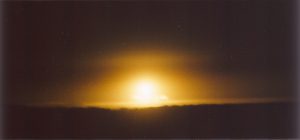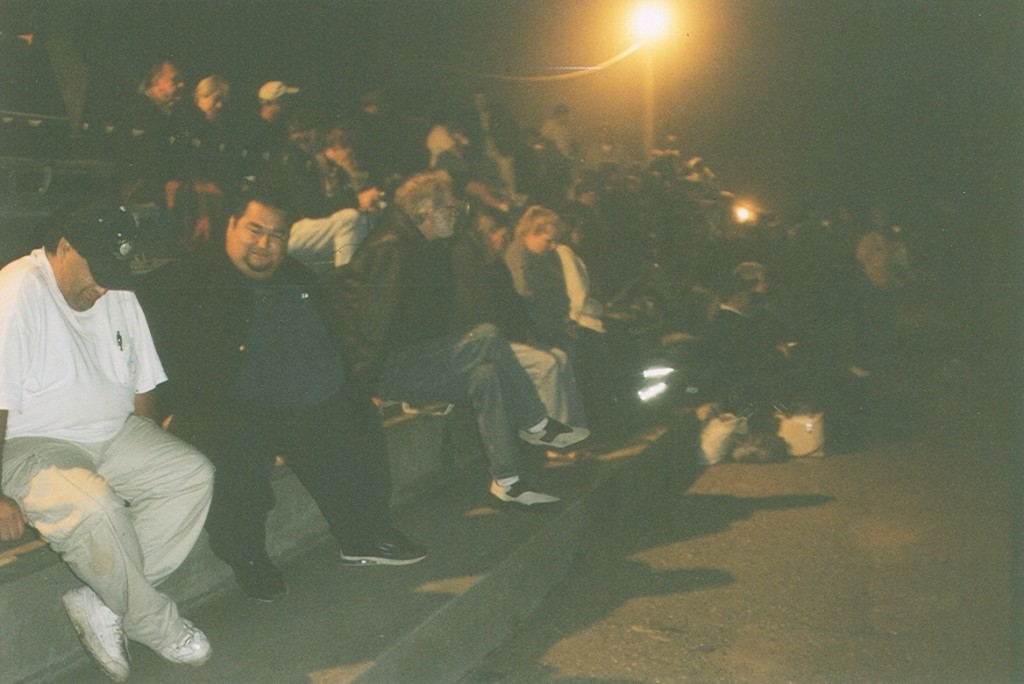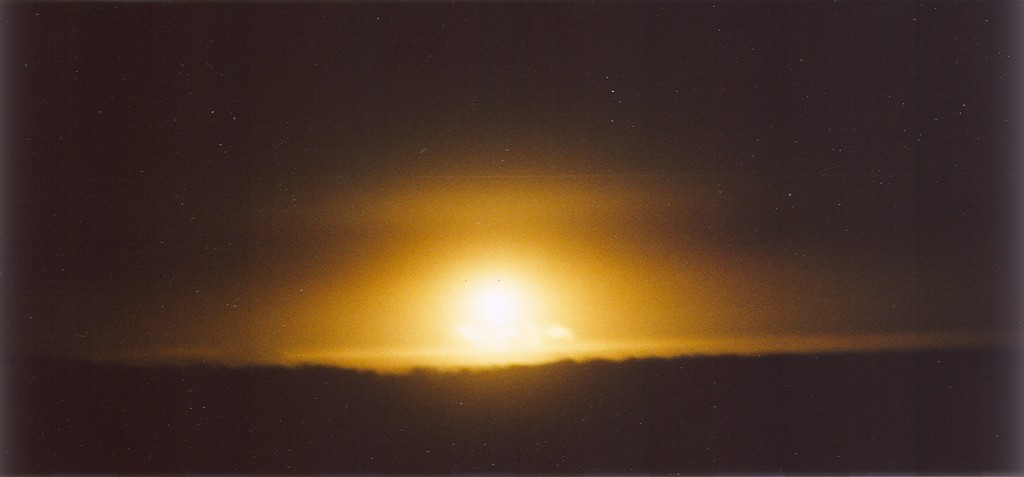MONDAY NIGHT. Actually, Tuesday morning, 1:30 AM. We get up and wander around. I’m awake, not having actually slept. Lee brews her coffee. What with one thing and another, we get out the door at about 2:10. There is a low cloud layer. Very low: the searchlight from the nearby private airport sweeps by every 30 seconds, a solid beam of light. Very soon we are driving up to the mesa, through patchy fog. Before long the fog is more than patchy. We grope our way along the winding two-lane to Guadalupe, where it eases up a little. But by the time we are nearing Vandenberg it’s back.
We find good old Firefighter Road and turn off. I can’t remember just how long the road is, and that’s almost disastrous. When the stop sign looms out of the fog I have to stand on the brakes and we come a few feet from going off into the eucalyptus forest straight ahead. As soon as we turn right toward the weather station observation point I see headlights coming our way. Uh-oh. It’s about 2:55, the bird is supposed to fly at 3:02 (I’d been worried we’d be late), and nobody should be leaving. I pull up to a group of people standing by a parked car and ask them if it’s been scrubbed. Yep. Phooey. I look around, decide to pull into the little parking lot to the south of the barricade and see what we might have seen if the launch had gone off on schedule.
Not much. We’re enveloped in fog. Not only can’t we see the pad, about three miles away, we can’t even see very far down the hill. Oh, well. We turn around and drive back through the fog.
What we’d come for was our first night launch at Vandenberg. It was to have gone off two nights before, but had been cancelled due to a problem with the canopy covering the payload, which was NASA’s AURA satellite. NASA describes it thus: “Earth Observing System (EOS) AURA is a NASA mission to study the Earth’s ozone, air quality and climate. This mission is designed exclusively to conduct research on the composition, chemistry and dynamics of the Earth’s upper and lower atmosphere employing multiple instruments on a single satellite. EOS Aura is the third in a series of major Earth observing satellites to study the environment and climate change and is part of NASA’s Earth Science Enterprise.”
AURA was to go up on a Delta 2 booster, which we saw on our first launch during the daytime. It is a two-stage liquid fuel rocket, with nine strap-on solid boosters. Supposed to be pretty spectacular at night. Maybe. When we get home we find the launch has been rescheduled for tomorrow night, same time, same place.
WEDNESDAY MORNING, 1:45 AM. Lee has decided not to bring coffee this time. I’ve decided we should get out at 2, since we were almost late the last time. More low clouds, not as much fog until we get there, when it closes in again. But we make better time anyway, and arrive at 2:30. We park, walk past the building of the 86th Weather Squadron (making a note to bring the damn flashlight for our next night launch) and over to the spectator area. This is a concrete grandstand with wooden seats, thoughtfully provided by Vandenberg and on launch days equipped with Bose outdoor speakers on stands to provide NASA commentary. There are bright lights behind us. Maybe 200 people are already there with their blankets and cameras and cell phones … at 2:40 in the morning!
We can’t see a thing, just like last night. I imagine that when the rocket goes off we’ll see a bright glow coming through the fog, and we’ll certainly hear it, but we were wishing for more.
Unfortunately, the weather here is fairly predictable this time of year: 70% chance of morning fog, beginning at about 1 AM.
We move into the planned 10-minute hold at T-4 minutes. During the hold all the mission controllers are polled, maybe 20 of them, all referred to by an acronym that means nothing to me, but they all say “go.” We sweat it out until the count is resumed: “T minus 4 minutes and counting.” A cheer goes up. At about T-3:30 someone says “Hold, hold, hold.” The launch window is 3 minutes long. The crew begins to recycle the count, which they still have time to do, in theory. But I think everybody knows it’s no-go. When you’re about to light a bomb under a $100 million or so worth of space hardware, you don’t take any chances. Sure enough, they call it off a few minutes later.
THURSDAY MORNING, 1:45 AM. I subscribe to a launch notification service. They send me an email about a week before any planned Vandenberg launch, and it was because of a quick notification from this guy Brian Webb, who runs the service, that we didn’t go down the first time the rocket was scheduled to fly. Since then I have found a site that provides updates every five minutes or so, in real time. I check in, and discover that the launch vehicle is being topped off with LOX at this very moment. Everything is go for launch. Earlier there had been concern that weather downrange might prevent a P-3 tracking plane from taking off in Mexico, but it now looks like an 80% probability it will be okay. We step outside …
… and see stars! All right! This is more like it. We hurtle through the night along the now very familiar highway, arrive at 2:30 again, and most of the same people are there. And we can see the pad! The night is just about perfect. There are some low clouds and fog out over the ocean, behind the pad, but overhead nothing but patchy high cirrus.
The audio commentary is very familiar by now. It’s almost a replay of last night. We get to the planned hold, ten minutes count down, and we’re at four minutes and counting. Another cheer. A woman comes running up to the grandstand and says something to her companion about hurrying back before they turned off the lights. Really?
Sure enough, at T-3 the grandstand goes dark. We look up, and can see thousands of stars and the Milky Way. Somebody at Mission Control has a sense of theater! It’s like waiting for the opening curtain; all we need is the overture.
The final poll is made. Ten items down the list somebody doesn’t answer. (SPG, or something like that. Who knows what it means?) There is a long, pregnant pause. Mission Control says “SPG negative,” and I can’t breathe. Then Mr. Asleep-at-the-wheel SPG comes on: “SPG, go.” “Roger, SPG, go.” I hope they fire that damn SPG guy.
Absolute silence as the count reaches zero.
Then … it’s daytime! I’m not kidding, the sky is lit up from horizon to horizon. Loud cheering and applause, including from me! Lee and I are laughing. The clouds and fog behind the rocket are bright as a milky sunset as it rises. A stage manager couldn’t have done it better. After a bit the sound starts hitting us. Up it goes, almost too bright to look at. They fire 6 of the solid boosters at lift-off, and they last a little over a minute. We could see them burn out and separate, then the other three ignited. And after that we could see the spent boosters tumbling: every time the burned, glowing ends faces us they flashed orange like little sparks.
We watched the thing for at least five minutes, way longer than you can see a launch in the daytime. I’m pretty sure I saw the last three boosters tumbling, too. We listened to Mission Control through Main Engine Cut-off (MECO), and ignition of the second stage.
Hard to drive home after something like that. I kept replaying it, wondering how I could possibly describe the glory of it. Answer: You can’t. You have to see it to believe it. Lee took a few pictures, which came out better than we expected, but can’t really convey the awesomeness of it.
When we got home I checked the website. We had driven 35 miles in about that many minutes. And now the satellite had passed over the South Pole and was coming up on the tracking station in Kenya …
THURSDAY NIGHT. I went out about midnight to see … fog, as far as the eye … well, the eye couldn’t see very far, all right? Dense as George W. Bush. Same thing for the next night. In other words, the night the AURA was launched was the only night in a week when we could actually have seen anything. I know it was a lot of hassle for the folks as NASA, but I’d like to thank them for their consideration.
WEDNESDAY, JULY 21, 2004. Midnight. I got an email alerting me to the launch of a Peacekeeper the previous morning. The Air Force only announces them 24 hours in advance, for security. The launch window was 6 hours, starting at 1:01 AM. We decided to go and so, yawning a bit, we headed down to Vandenberg in the fog.
The fog cleared as we got into the Santa Maria Valley, but closed in again as we climbed the hills into the base. We saw a deer, frozen in the headlights, clueless as George W. Bush in a kindergarten.
Hardly anybody at the weather station grandstand. There was a family of four, a single guy, and us. Four more people arrived at about T-1. But the lights were on and the speakers were set up. Air force launches are not nearly as chatty as NASA launches. I got the impression it was just three or four guys and one woman, going down a 140-or-so-item checklist.
The Peacekeeper really ought to be easy to launch. It has 3 solid-fuel stages and a fourth liquid-fuel “bus” which contains 10 MIRVed warheads. It’s supposed to be ready to rise from its silo in minutes, not hours or days. This, in fact, was supposed to be the next-to-last launch ever of a Peacekeeper.
I’m going to stop calling it that. This weapon started life in the ‘70s as the MX. Reagan decided to call it the Peacekeeper. Hell of a name for a thing like that. Ten 300-kiloton warheads adds up to 3 megatons. You can keep a hell of a lot of peace with that. (The Hiroshima bomb was rated at 15 kilotons.) True, it was designed to take out hardened missile silos and underground command posts with its extreme accuracy. But you spread 3 megatons out over, say, Moscow, and presto, no more Moscow. 10 million dead? Easily. Another 10 million horribly wounded.
At first the MX was to be carried on trucks that would shuffle around between hundreds of hardened installations covering a huge area of the desert somewhere, the idea being we could play a little 3-card monte with the Russians, they’d never know which bunkers held real missiles, so they would have to hit them all. That was rejected and it was decided to put them on railcars and keep moving them, presumably staying comfortably within the poorest neighborhoods. If you’ve ever ridden a passenger train you’ll know what I’m talking about. You don’t see a lot of mansions, you see a lot of junkyards and tumbledown shacks. Anyway, they gave up on that as well and adapted the missiles to Minuteman silos, which, I believe, was exactly the situation we were trying to avoid … but who cares? It’s only money. Between $400 and $700 million per MX, depending on who you listen to. About 100 were authorized, but fewer were built. Now, with the whole program due to be phased out this year under the terms of the (unratified) SALT II Treaty, I guess they’re just using them for practice. Otherwise they’d just be cut up for junk. This one was selected at random and trucked here with its crew.
But we didn’t get to see this warbird fly. We listened to the cryptic comments of launch control, with long gaps. We gazed into the thick fog and were informed that they were entering the final countdown. Then, almost an afterthought, somebody muttered “launch.” What? Did that mean it just left? No more info was forthcoming until the low rumble reached us about 20 seconds later. Loud, but not as loud as a Delta.
What we didn’t see (and what you didn’t see either, come to think of it): The MX was ejected out of its underground canister by pressurized steam. At about 300 feet it was nearly motionless as the engine ignited. Then it took off like a bat out of Hell. Or maybe a bat returning to Hell. About 30 minutes later the 10 warheads streaked down like a meteor shower over Kwajalein Atoll in the Pacific.
I love rockets and would have loved to have seen this launch, but not all rockets are created equal. Our previous two launches have been for NASA, and the sense of exhilaration was huge. This time, as I listened to the rumble die away, I thought this is what the end of the world will sound like. You have about an hour to get your affairs in order, do all those things you neglected to do, find the ones you love and tell them you wish you had told them more often that you love them.
Or not. More likely not.
On the way out we stopped to watch a doe and her fawn get out of our way, and then a bigger deer bounded along beside us in the fog. Peace is a wonderful thing.
July 21, 2004
Oceano, California



